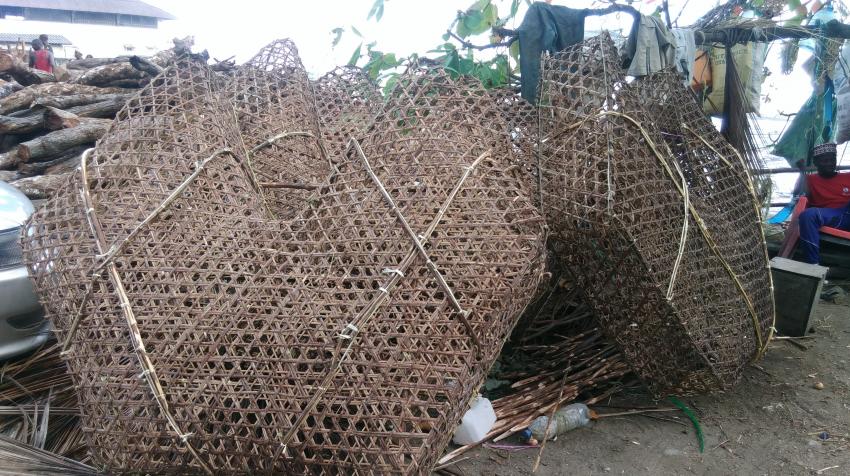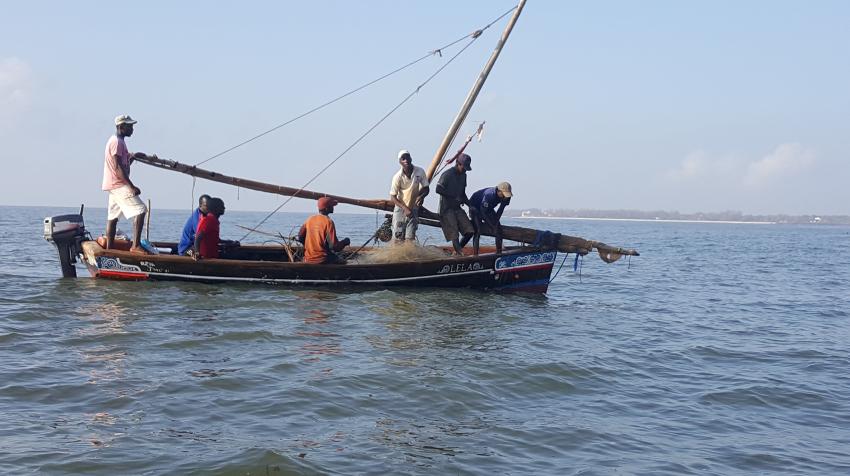8 June 2020
The Kenyan marine and coastal environment
Kenya’s coastline extends 600 km, from its border with Somalia in the north to Tanzania in the south. With the emergence of the global COVID-19 pandemic, Kenya’s coastal and marine landscape has changed in ways that were unimaginable just a few months earlier. The coastline features a number of economic activities that support local communities and the Kenyan population at large. It hosts a unique network of interdependent marine ecosystems, including mangroves, seagrass and coral reefs, which act as critical habitats. They serve as nurseries as well as feeding and breeding grounds for diverse species, some of which are endemic and endangered. These ecosystems are intertwined and are critical in supporting hydrological cycles, carbon stocks, pollution filtration, climate change mitigation, and shoreline and coastal protection.
It is widely known that the economic value of coastal protection provided by coral reefs and mangroves in the Western Indian Ocean is estimated at $1.2 billion annually.1 Healthy and functioning coastal and marine ecosystems underpin the provision of the sustainable goods and services that are essential for the well-being of society. These ecosystems support food security and contribute to subsistence livelihoods, human health and other socioeconomic dimensions, including offering future opportunities such as in medical drugs and bioprospecting. The international community has aligned around the United Nations 2030 Agenda for Sustainable Development, which defines “the future we want”, described by the Sustainable Development Goals (SDGs). Undoubtedly, these 17 goals identify key societal, economic and environmental aspirations for all countries to achieve sustainable development.
For the first time, the oceans and water bodies have been included through SDG 14, which deals with life below water. For countries like Kenya, this is a welcome focus and a call to the world to conserve and sustainably use the oceans, seas and marine resources for sustainable development. This also speaks to the sustainability aspects of our emerging blue economy dialogue. SDG 14, Kenya’s Development Plan (Vision 2030) and our County Development Plans (CDPs) all acknowledge the oceans in supporting natural resources towards economic advancement.
The Kenyan Government’s Big 4 Agenda of Vision 2030 focuses on food and nutrition security, affordable housing, manufacturing and affordable universal healthcare. In order to achieve the food and nutrition security target, fisheries have been prioritized among the sectors with a high potential for spurring national economic growth. The Blue Economy Initiative (BEI) has identified the contribution of the renewable resources within the aquatic environment and the potential contribution to Kenya’s socio-economic well-being, food security and industrial development. The blue economy sectors comprise fisheries, maritime transport, travel and tourism, shipping and maritime transport, oil and gas, mining, aquatic sports and culture, the film industry and, of course, coastal agriculture, including mariculture.
Fisheries, maritime transport, travel and tourism have been heavily impacted by the COVID-19 pandemic due to restrictions on movement constituting curfews, lockdowns and stay-at-home policies. In addition to curtailing the movement of people, these restrictions have disrupted the supply and demand chain of seafood products and led to other broken economic chains. The fisheries sector has seen a reduction of fishers venturing out to sea, and the tourism sector has also been heavily impacted.
Fisheries and livelihoods
Kenya’s marine fishing area in the territorial waters and the Exclusive Economic Zone (EEZ), spans approximately 230,000 km2. The fishing capacity comprises about 3,000 small-scale fishing crafts and approximately 14,000 fishers that are critical to the provision of food and nutrition security, livelihoods and economic development for coastal communities. They support more than 70 per cent of households either directly or indirectly through artisanal fisheries and tourism activities. The economic importance of fisheries and tourism activities is demonstrated by the sizable populations that they support. Fisheries (capture and aquaculture) directly and indirectly support 1.2 million Kenyans with its annual production of 24,709 metric tons of seafood, worth 4.6 billion Kenya shillings.2 This is in spite of the challenges of overfishing and declining catches, and the need to implement measures that could lead to the recovery of overfished stocks and degraded habitats. Amid the ongoing COVID-19 pandemic, coastal communities are hard hit since they rely on fishing. The fishers cannot work as they used to; fishing boats are kept anchored more often than not, thus disrupting the market supply of fish. In addition, boat owners are unwilling to fuel their fishing boats to catch fish that will not be bought immediately, given the perishable nature of fish products, in a time in which the hotels and eateries are closed, and the cold chain infrastructure is not very developed. Thus, along the coastline in the different fish landing sites, the catches have collapsed and the small-scale fishers as well as fishmongers, mostly women ‘Mama karanga’, have been severely hurt.

The export business of seafood and aquarium fisheries has been affected because the disruption of shipping logistics has made labourers and the workers in such chains redundant. On the same note, the traffic of cargo ships has tremendously declined, and the seafarers who have been deployed aboard cruise liners are either docked far from Kenya or are staying at home. In the field of ocean science, at the local, national and global levels, there has been a severe impact on scientific research, work and data gathering, since scientists have not recorded the information necessary to assess the status of marine and related ecosystems due to lockdowns and curfews.
Tourism and fisheries
The Kenyan coast has a vibrant tourism sector that has also been heavily affected by the pandemic. The latest statistics show that there were 2,048,834 foreign visitors to Kenya in 2019, compared with 2,025,206 in 2018.3 While these numbers were expected to rise in 2020, the sector is in lockdown, which has heavily disrupted the supply of seafood to the hotel industry, especially much-loved commercial species like lobster, prawn and snapper. This observation has clearly demonstrated the tight link between the tourism and fisheries sectors during the COVID-19 pandemic. Thus, it is now evident that in Kenya, a great part of the fishery economy is strongly linked to the vibrant tourism sector. Furthermore, in many instances, the fishers also engage in ecotourism activities by taking tourists fishing, diving or sampling local cuisines in local villages; these commercial activities have also been severely impacted.
Cross-sectoral application of scientific knowledge
Ocean science is expansive, just like the ocean itself. As clearly demonstrated during the COVID-19 pandemic, there is a need for cross-sectoral work between ocean scientists and the other sectors of the blue economy beyond fisheries, including tourism; other natural resources industries, such oil, gas, mining, mariculture, sports and culture; and shipping and maritime affairs. The aim of such work should be to increase scientific knowledge, develop research capacity, transfer/share marine technology and interconnect all blue economy activities. There is also a need to invest in disseminating relevant science and raising its visibility to ensure that the benefits of investing in such collaborative efforts becomes part of our national dialogues.
It is important to recognize that cross-sectoral partnerships and collaborative efforts lag behind, severely limiting the generation, archiving and sharing of data, innovation and marine technology. Going forward, this situation requires attention at the local, national and global levels, particularly during the much-awaited 2020 United Nations Ocean Conference, now postponed due to the COVID-19 pandemic. We all believe that at this global meeting, to be co-hosted by Kenya and Portugal, the aspirations of the United Nations Decade of Ocean Science for Sustainable Development (2021-2030), to guide the development of the global ocean economy, will not only be adopted but also supported.

Conclusions and recommendations
The COVID-19 pandemic is an emerging driver over and above global climate change, which has been added to the list of risk factors influencing sustainable development and the exploitation of ocean resources. Due to the pandemic, curfews, partial lockdowns, the suspension of international flights and shipping, and restricted movements of people have severely interrupted not only the fisheries supply and demand chain but also the tourism sector. The situation has resulted in the near total collapse of livelihoods centred around fisheries, tourism and related economic activities.
The knowledge generated by ocean science is important in understanding conservation actions aimed at safeguard the environments that provide for the fisheries and tourism economy. We believe that the importance of science in understanding life under water can yield many positive results and lead to innovations in the coming days in the following areas:
1. Finding new ways of conducting marine research remotely using mobile apps to collect data that can be analysed by ocean scientists to provide information on the status of fisheries and the environment, as well as combat illegal, unreported and unregulated fishing, and increase security in the national marine space;
2. Developing innovations in habitat restorations that allow for experiential tourism for both local and international visitors;
3. Supporting communities to develop nature-based ecotourism and other ventures that could serve as sustainable destinations for tourists and related blue economy activities;
4. Undertaking a Marine Spatial Plan (MSP) in which 30 per cent of the national marine space would be earmarked for protection to assure that sustainable conservation, marine environment protection and ocean development are guided by an agreed and approved National Maritime Master Plan; and
5. Strengthening the base for the Ocean Teacher Academy or a National Institute for Ocean Science and Technology to foster a world population that is fully aware and knowledgeable of its intrinsic and inextricable connectivity with the ocean.
Notes
1 David Obura and others, Reviving the Western Indian Ocean Economy: Actions for a Sustainable Future (Gland, Switzerland, WWF International, 2017), p. 19. Available at https://sustainabledevelopment.un.org/content/documents/13692WWF2.pdf.
2 Edward Kimani, Christopher Aura and Gladys Okemwa, eds., The Status of Kenya Fisheries: Towards the Sustainable Exploitation of Fisheries Resources for Food Security and Economic Development (Mombasa, Kenya, Kenya Marine and Fisheries Research Institute, 2018), p. vii. Available at https://www.kmfri.co.ke/images/pdf/Status_of_Fisheries_Report_New_31-10-2019.pdf.
3 Patrick Alushula, “Kenya's tourism earnings grow to $1.6b as 2019 arrivals stay above 2m”, The East African, 10 January 2020. Available at https://www.theeastafrican.co.ke/business/Kenya-tourism-earnings-grow-in-2019/2560-5413508-timn7fz/index.html.
The UN Chronicle is not an official record. It is privileged to host senior United Nations officials as well as distinguished contributors from outside the United Nations system whose views are not necessarily those of the United Nations. Similarly, the boundaries and names shown, and the designations used, in maps or articles do not necessarily imply endorsement or acceptance by the United Nations.




